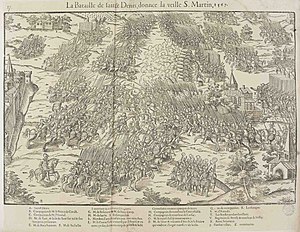
Antoine of Bourbon was the King of Navarre through his marriage to Queen Jeanne III, from 1555 until his death. He was the first monarch of the House of Bourbon, of which he became head in 1537. Despite being first prince of the blood in France, Navarre lacked political influence and was dominated by king Henry II of France's favourites, the Montmorency and Guise families. When Henry II died in 1559, Navarre found himself sidelined in the Guise-dominated government, and then compromised by his brother's treason. When Henry's son, king Francis II of France, soon died in turn, Navarre returned to the centre of politics, becoming Lieutenant-General of France and leading the army of the crown in the first of the French Wars of Religion. He died of wounds sustained during the Siege of Rouen. He was the father of king Henry IV, France's first Bourbon king.
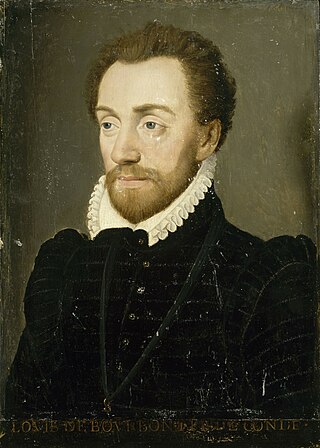
Louis de Bourbon, 1st Prince of Condé was a prominent Huguenot leader and general, the founder of the Condé branch of the House of Bourbon. Coming from a position of relative political unimportance during the reign of Henri II, Condé's support for the Huguenots, along with his leading role in the conspiracy of Amboise and its aftermath, pushed him to the centre of French politics. Arrested during the reign of Francis II then released upon the latter's premature death, he would lead the Huguenot forces in the first three civil wars of the French Wars of Religion before being executed after his defeat at the Battle of Jarnac in 1569.
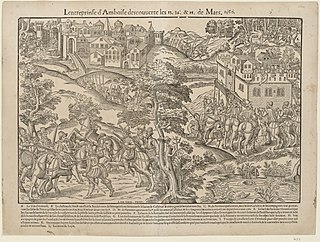
The Amboise conspiracy, also called Tumult of Amboise, was a failed attempt by a Huguenot faction in France to gain control over the young King Francis II and to reverse the policies of the current administration of Francis, Duke of Guise and Charles, Cardinal of Lorraine through their arrest, and potentially execution. Malcontent factions of Huguenots had been chafing under the French crown since the reign of Henry II and with the arrival of a new young king, saw their chance to take power for themselves. However the plot was uncovered ahead of time, and the Guise were ready for them. As such hundreds would be arrested, and many killed. Louis I, Prince of Condé was suspected of involvement, however he was able to flee south, and it was only after some months that the Guise were able to put him on trial. Shortly thereafter, the sickly Francis II died, their hold on the administration collapsed, and with it the conviction of Condé. This tumult would be one of the key steps in the collapse of crown authority that led to the first French War of Religion.

The Edict of Saint-Germain, also known as the Edict of January, was a landmark decree of tolerance promulgated by the regent of France, Catherine de' Medici, in January 1562. The edict provided limited tolerance to the Protestant Huguenots in the Catholic realm, though with counterweighing restrictions on their behaviour. The act represented the culmination of several years of slowly liberalising edicts which had begun with the 1560 Edict of Amboise. After two months the Paris Parlement would be compelled to register it by the rapidly deteriorating situation in the capital. The practical impact of the edict would be highly limited by the subsequent outbreak of the first French Wars of Religion but it would form the foundation for subsequent toleration edicts as the Edict of Nantes of 1598.

Jacques d'Albon, Seigneur de Saint-André was a French governor, Marshal, and favourite of Henri II. He began his career as a confident of the dauphin during the reign of François I. Saint André and the prince were raised together under the governorship of his father at court. In 1547, at the advent of Henri's reign, he was appointed as his father's deputy, serving as lieutenant general for the Lyonnais. Concurrently he entered the king's conseil privé and was made a Marshal and Grand Chamberlain.

Gaspard de Saulx, sieur de Tavannes was a French Roman Catholic military leader during the Italian Wars and the French Wars of Religion. He served under four kings during his career, participating in the Siege of Calais (1558) and leading the royal army to victory in the third civil war at the Jarnac and Moncontour. A strong Catholic, he founded the confraternity of the holy ghost in 1567 which would be a template for other militant Catholic organisations across France. He died in 1573, shortly after the opening assassinations of the Massacre of Saint Bartholomew, which he had helped plan.

The siege of Rouen was a key military engagement of the first French War of Religion. After having been seized by those opposing the crown on 16 April, the siege, beginning on 28 May and culminating on 26 October brought the important city of Rouen back into the crowns control. The fall of Rouen would set the stage for the main battle of the war at Dreux several months later.
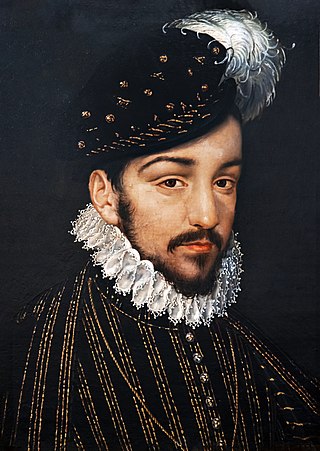
The Peace of Longjumeau was signed on 23 March 1568 by Charles IX of France and Catherine de' Medici. The edict brought to an end the brief second French Wars of Religion with terms that largely confirmed those of the prior edict of Amboise. Unlike the previous edict it would not be sent to the Parlements to examine prior to its publication, due to what the crown had felt was obstructionism the last time. The edict would not however last, and it would be overturned later in the year, being replaced by the Edict of Saint-Maur which outlawed Protestantism at the beginning of the third war of religion.

Vergt is a commune in the Dordogne department in Nouvelle-Aquitaine in southwestern France.

The surprise of Meaux was a failed coup attempt by leading aristocratic Huguenots which precipitated the second French War of Religion. Dissatisfied with their lot, and under the pretext of fear of extermination, Louis, Prince of Condé and Gaspard II de Coligny plotted to seize the king, Charles IX, while he was staying near Meaux. Alerted by the mustering of the Huguenots, the royal court made a dash for Paris, fighting off attempts to break through to them en route. Their plan foiled, the Huguenots laid siege to the city, beginning the second war. The event would be of lasting importance in the reputation it gave its architects for sedition.

The siege of Chartres was a key event of the second French Wars of Religion. The siege saw the Huguenot forces fail to take the heavily defended town, ultimately concluding the second civil war in a negotiated settlement a week later. One of the very few engagements in the second civil war, the siege was led by Louis, Prince of Condé, fresh off regrouping after his defeat at the Battle of Saint-Denis. The defensive efforts were run by the military governor of Chartres, Nicolas des Essars, Sieur de Linières.

Léonor d'Orléans, duc de Longueville was prince de Châtellaillon, marquis de Rothelin, comte de Montgommery et Tancarville, viscomte d'Abbeville, Melun, comte de Neufchâtel et Valangin. Longueville was governor of Picardy, the leader of one of the Prince étranger families of France and a descendant of the bastard of Orléans who was in turn a descendant of Charles V of France.
The Battle of Dormans was fought on 10 October 1575, during the 5th War of Religion in France, between the armies of Henry I, Duke of Guise and the Huguenot-recruited German army of John Casimir of the Palatinate-Simmern.

Charles de Bourbon, Prince de la Roche-sur-Yon,, was a Prince of the Blood and provincial governor under three French kings. He fought in the latter Italian wars during the reign of Henri II, commanding an army during the 1554 campaign into the Spanish Netherlands.

The siege of Orléans was the final key military engagement of the first French War of Religion. Having lost the Battle of Dreux the rebel Huguenots fell back with their remaining forces to the city. François, Duke of Guise, the only non captive royal commander, moved to lay siege to the town, hoping its capitulation would bring about a total victory for the crowns forces. However, despite reducing the suburbs, he would be assassinated at the siege before he could bring it to a conclusion. As a result the captive Louis, Prince of Condé and Anne de Montmorency at Catherine de' Medici's direction were able to negotiate a compromise end to the first war in the Edict of Amboise.

The Estates General of 1560–1561 was a national meeting of the three estates of France, the clergy, nobility and commoners convoked by François II, though he would die before it could begin. It represented the first meeting of the estates general in 76 years, the last one having been convened by Charles VIII at Tours. Meeting at Orléans the estates would be tasked with providing solutions to the crowns dire fiscal problems, a legacy of the Habsburg–Valois Wars, and the growing religious problem caused by the Reformation. The estates would however be unable to finish their deliberations, with Catherine de' Medici proroguing the session, and reconvening the estates general at a later date in 1561 at Pontoise, where she sought a more agreeable selection of delegates. Ultimately the work of the estates would solve neither the crowns fiscal insolvency or the religious conflict, which exploded in the first French War of Religion.
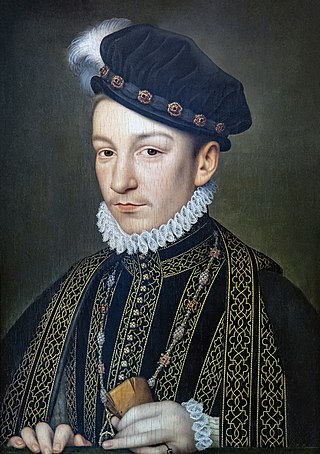
The Edict of Saint-Maur was a prohibitive religious edict, promulgated by Charles IX of France at the outbreak of the third war of religion. The edict revoked the tolerance that had been granted to Protestantism, in the edicts of Saint-Germain, Amboise and the peace of Longjumeau. The edict forbade the exercise of any religion other than Catholicism in the kingdom of France, and gave Protestants 15 days to vacate the kingdom. Ultimately the edict would be overturned in the landmark peace of Saint-Germain-en-Laye at the end of the third religious war in 1570 which restored recognition to Protestantism, alongside many other concessions.

The Edict of Amboise (1560) was a decree that created the framework to separate heresy from sedition, promulgated by the young king Francis II on the advice of his council and mother Catherine de' Medici. The edict was the first promulgated in France that lessened the persecution of Huguenots through the provision of amnesty for past religious crimes on the condition the offender returned to the Catholic fold. The edict was published during the Amboise conspiracy whilst the royal court was resident in the Château d'Amboise and their authority over France was shaken. It would be superseded first by the Edict of Romorantin in May of the same year, then the Edict of July and finally the Edict of Saint-Germain

The Edict of 19 April was a religious edict promulgated by the regency council of Charles IX of France on 19 April 1561. The edict would confirm the decision of the Estates General of 1560-1 as regarded the amnesty for religious prisoners. The edict would however go further in an effort to calm the unrest that was sweeping France, outlawing the use of religious epithets and providing a pathway for religious exiles to return to the country. Despite not being an edict of toleration for Protestantism, the more conservative Catholics would interpret the edict as a concession to the Huguenots, leading to the Parlement of Paris to remonstrate the crown. The edict would be endorsed and furthered in the more sweeping Edict of July a few months later, before it in turn was superseded by the first edict of toleration, the Edict of Saint-Germain.
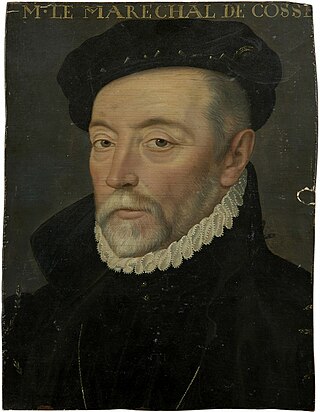
Artus de Cossé, seigneur de Gonnor and Comte de Secondigny (1512–1582), was a Marshal of France, an office he was elevated to in 1567. He served to administer the armies finances during the first of the French Wars of Religion and would lead the royal army in its pursuit of the Prince of Condé during the second civil war. His failure to catch the army led to his dismissal from overall royal command. During the third civil war he would again lead troops, beating a small Protestant force, before being defeated in the final days of the war at Arney-le-Duc. His long history of Politique leanings would push him into the orbit of the Malcontents for which he would be arrested in 1574. In 1576 he would be released and restored to favour before he died in 1582.
